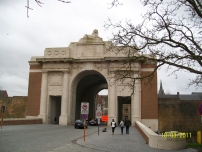| First Name: | Frederick William | Last Name: | CLARKE | |
|---|---|---|---|---|
| Date of Death: | 31/10/1914 | Lived/Born In: | Wandsworth | |
| Rank: | Private | Unit: | Dragoon Guards2 | |
| Memorial Site: | Menin Gate, Ypres | |||
Current Information:
Age-21
Born-Kensington
The Race to the Sea September-October 1914 By the middle of September 1914, the Aisne battlefield had stagnated into trench warfare and in order to break this impasse, both sides tried to outflank each other in a general movement northwards. Moving up through Picardy, Artois and Flanders the race was over by 19th October when the North Sea was reached. The Western Front, a line of trenches stretching from Belgium to Switzerland, was now a reality. Initially it was the French army that conducted this movement whilst the British Expeditionary Force remained on the Aisne but by 6th October British reinforcements were needed to help beat off German attacks around Lille. They moved north and along with reinforcements from Britain, they took up new positions in Flanders, on the left of the Allied line and much closer to the Channel ports. The Battle of Messines 12th October-2nd November 1914 The Battle of Messines was fought in October 1914. It was part of the Race to the Sea and it took place between the Comines-Ypres canal and the River Douve. It involved the 1st and 2nd Cavalry Divisions and elements of the 3rd, 4th and 5th Divisions as well part of the Indian Division.
In the early morning of 31st October, there was a strong German attack at Messines against part of 1st Cavalry Division, including 2nd Dragoon Guards of 1 Cavalry Brigade. At first the attack was repelled but at 8 am the Germans began a heavy bombardment of Messines followed an hour later by an Infantry attack with their machine guns active in some nearby brickfields. It soon became evident that the twelve weak squadrons defending Messines could not hold on against twelve German battalions at odds of six to one or more.. Soon the enemy had broken into the north of the village and there was also a gap to the south-east. At 10 am the Germans renewed their attack and 1 Cavalry Brigade was forced back from house to house. By noon the British line of defence had withdrawn to the main street, well within the western half of the village. The heavy fighting continued all day but the line held, despite the German artillery setting the British part of the village ablaze. The enemy suffered many casualties and did not manage to establish a continuous line through the village until the evening. At 9 pm, 2 Cavalry Brigade relieved 1 Cavalry Brigade successfully despite the closeness of the enemy. Among the casualties suffered by 2nd Dragoon Guards during the course of the day was Frederick Clarke who was killed in action.
|
||||
| « Back to Search Results | ||||
| If you think any of the information shown here is incorrect, Click Here to submit your amends and comments | ||||




